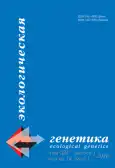The genetic structure of populations of specially protected species Androsace kozo-poljanskii ovsz. in conditions of the south at the central Russian upland using dna markers
- Authors: Snegin E.A1, Snegina E.A1, Novomlinskaya T.A1
-
Affiliations:
- Belgorod national research university
- Issue: Vol 14, No 1 (2016)
- Pages: 3-12
- Section: Articles
- URL: https://journals.rcsi.science/ecolgenet/article/view/2743
- DOI: https://doi.org/10.17816/ecogen1413-12
- ID: 2743
Cite item
Full Text
Abstract
Full Text
##article.viewOnOriginalSite##About the authors
Edward A Snegin
Belgorod national research university
Email: snegin@bsu.edu.ru
Dr.Biol.Sci., the senior lecturer, the head of department of ecology, physiology and biological evolution
Elena A Snegina
Belgorod national research university
Email: sneginа@bsu.edu.ru
assistant of department of ecology, physiology and biological evolution
Tatiana A Novomlinskaya
Belgorod national research university
Email: sneginа@bsu.edu.ru
undergraduate of department of ecology, physiology and biological evolution
References
- Виноградов Н.П., Голицын С.В. «Сниженные Альпы» и тимьянники Среднерусской возвышенности // Ботанический журн. - 1954. - Т. 39. - № 3. - С. 423-430. [Vinogradov NP, Golitsyn SV. Snizhennye-alpy-i-timyanniki-srednerusskoj-vozvyshennosti. Botanical Journal. 1954;39(3):423-430. (In Russ).]
- Голицын С.В. К флоре восточного крыла Верхнего Поосколья // Ботанический журнал СССР. - 1956. - № 10. - С. 1428-1438. [Golitsyn SV. To the flora of the eastern wing of the Upper Prioskolie. Botanical Journal of the USSR. 1956(10):1428-1438. (In Russ).]
- Динамика популяционных генофондов при антропогенных воздействиях / Под ред. Ю.П. Алтухова. - М.: Наука, 2004. [The population dynamics of the gene pools in the anthropogenic impacts. Ed by Y.P. Altukhova. Moscow: Nauka; 2004. (In Russ).]
- Шмальгаузен И.И. Факторы эволюции. Теория стабилизирующего отбора. - М.: Наука, 1968. [Shmal’gauzen II. The factors of evolution. The theory of stabilizing selection. Moscow: Nauka; 1968. (In Russ).]
- Burnham KP, Overton WS. Estimation of the size of a closed population when capture probabilities vary among animals. Biometrika. 1978;(65):625-633.
- Chao A. Species richness estimation. In: Balakrishnan N, Read CB, Vidakovic B, editors. Encyclopedia of Statistical Science. New York: Wiley; 2005. P. 7907-7916.
- Chao А, Shen T-J. SPADE. 2009. http://chao.stat.nthu.edu.tw.
- Excoffier L, Smouse PE, Quattro JM. Analysis of molecular variance inferred from metric distances among DNA haplotypes: application to human mitochondrial DNA restriction data. Genetics. 1992;(131):479-491.
- Ewens W. The sampling theory of selectively neutral alleles. Theor Pop Biol. 1972;(3):87-112.
- Manly BFJ. The Statistics of Natural Selection on Animal Populations. London: Chapman and Hall; 1985.
- Nei M. Genetic distance between populations. The American Naturalist. 1972;106(949):283-292.
- Nei M. Molecular population genetics and evolution. Amsterdam;1975.
- Peakall R, Smouse PE. GenAlEx V5: Genetic Analisis in Excel. Population genetic software for teaching and reseach. Australion National University, Canberra, Australia. 2001. http://www.anu.edu.au./BoZo/GenAlEx/.
- Slatkin M. Isolation by distance in equilibrium and non - equilibrium populations. Evolution. 1993;47(1):294-279.
- Silvertown J, Lovett Doust J. Introduction to plant population biology. Blackwell Scientific. Oxford; 1993; 210 p.
- Tamura K, Peterson D, Peterson N, et al. MEGA5: Molecular Evolutionary Genetics Analysis using Maximum Likelihood, Evolutionary Distance, and Maximum Parsimony Methods. Molecular Biology and Evolution. 2011. http://www.kumarlab.net/publications.
- Watterson G. The homozygosity test of neutrality. Genetics. 1978;88:405-417.
- Wright S. Isolation by distance. Genetics. 1943;28:114-138.
- Wright S. The genetical structure of populations. Ann. Eugenics. 1951;(15):323-354.
- Yeh FC, Yang R, Boyle TJ, et al. POPGENE 32, Microsoft Window-based Freeware for Population Genetic Analysis, Version 1.32; Molecular Biology and Biotechnology Centre, University of Alberta: Edmonton, Canada. 2000. http://www.ualberta.ca/~fyeh/popgene_download.html.
- Zietkiewicz E, Rafalski A, Labuda D. Genome fingerprinting by simple sequence repeat (SSR) - anchored polymerase chain reaction amplification. Genomics. 1994;20(2):176-181.
Supplementary files






